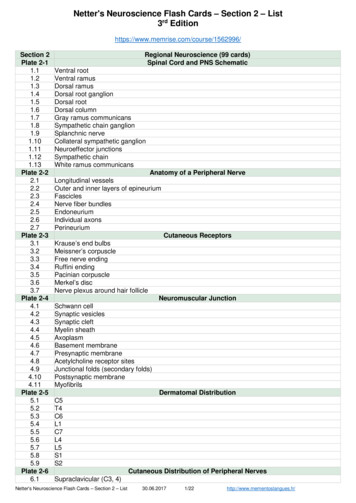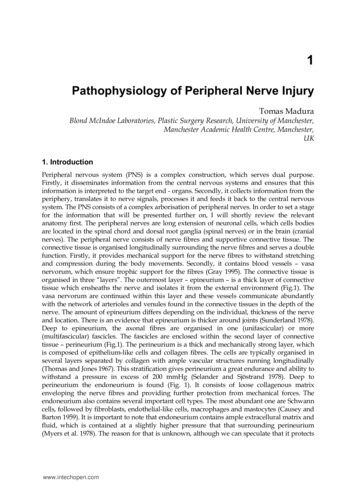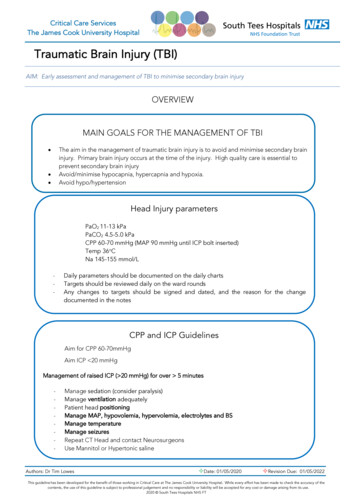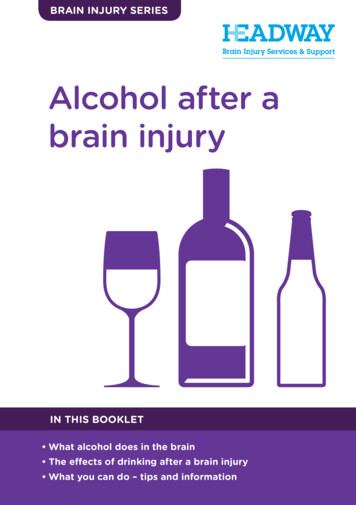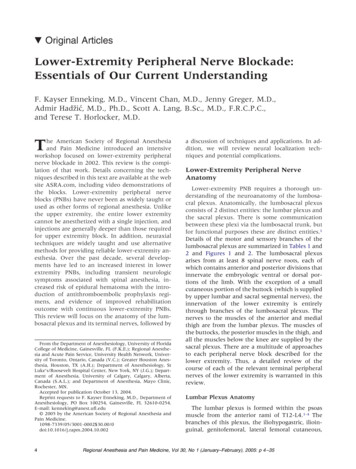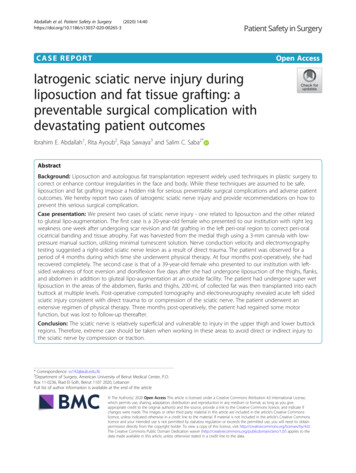
Transcription
Abdallah et al. Patient Safety in Surgery(2020) E REPORTOpen AccessIatrogenic sciatic nerve injury duringliposuction and fat tissue grafting: apreventable surgical complication withdevastating patient outcomesIbrahim E. Abdallah1, Rita Ayoub2, Raja Sawaya3 and Salim C. Saba2*AbstractBackground: Liposuction and autologous fat transplantation represent widely used techniques in plastic surgery tocorrect or enhance contour irregularities in the face and body. While these techniques are assumed to be safe,liposuction and fat grafting impose a hidden risk for serious preventable surgical complications and adverse patientoutcomes. We hereby report two cases of iatrogenic sciatic nerve injury and provide recommendations on how toprevent this serious surgical complication.Case presentation: We present two cases of sciatic nerve injury - one related to liposuction and the other relatedto gluteal lipo-augmentation. The first case is a 20-year-old female who presented to our institution with right legweakness one week after undergoing scar revision and fat grafting in the left peri-oral region to correct peri-oralcicatricial banding and tissue atrophy. Fat was harvested from the medial thigh using a 3-mm cannula with lowpressure manual suction, utilizing minimal tumescent solution. Nerve conduction velocity and electromyographytesting suggested a right-sided sciatic nerve lesion as a result of direct trauma. The patient was observed for aperiod of 4 months during which time she underwent physical therapy. At four months post-operatively, she hadrecovered completely. The second case is that of a 39-year-old female who presented to our institution with leftsided weakness of foot eversion and dorsiflexion five days after she had undergone liposuction of the thighs, flanks,and abdomen in addition to gluteal lipo-augmentation at an outside facility. The patient had undergone super wetliposuction in the areas of the abdomen, flanks and thighs. 200 mL of collected fat was then transplanted into eachbuttock at multiple levels. Post-operative computed tomography and electroneurography revealed acute left sidedsciatic injury consistent with direct trauma to or compression of the sciatic nerve. The patient underwent anextensive regimen of physical therapy. Three months post-operatively, the patient had regained some motorfunction, but was lost to follow-up thereafter.Conclusion: The sciatic nerve is relatively superficial and vulnerable to injury in the upper thigh and lower buttockregions. Therefore, extreme care should be taken when working in these areas to avoid direct or indirect injury tothe sciatic nerve by compression or traction.* Correspondence: ss192@aub.edu.lb2Department of Surgery, American University of Beirut Medical Center, P.O.Box 11-0236, Riad El-Solh, Beirut 1107 2020, LebanonFull list of author information is available at the end of the article The Author(s). 2020 Open Access This article is licensed under a Creative Commons Attribution 4.0 International License,which permits use, sharing, adaptation, distribution and reproduction in any medium or format, as long as you giveappropriate credit to the original author(s) and the source, provide a link to the Creative Commons licence, and indicate ifchanges were made. The images or other third party material in this article are included in the article's Creative Commonslicence, unless indicated otherwise in a credit line to the material. If material is not included in the article's Creative Commonslicence and your intended use is not permitted by statutory regulation or exceeds the permitted use, you will need to obtainpermission directly from the copyright holder. To view a copy of this licence, visit http://creativecommons.org/licenses/by/4.0/.The Creative Commons Public Domain Dedication waiver ) applies to thedata made available in this article, unless otherwise stated in a credit line to the data.
Abdallah et al. Patient Safety in Surgery(2020) 14:40BackgroundAutologous fat transplantation is a very popular technique used by plastic surgeons to correct soft tissue defects. Procedures that employ fat transplantation includebreast augmentation, scar and burn treatments, treatment of atrophies of the face and limbs, facial rejuvenation and gluteal augmentation [1]. This technique iscarried out in three steps: liposuction, fat processing,and fat grafting [2]. Similar to other procedures, liposuction and fat grafting are associated with several complications. Liposuction complications include swelling,seroma, hematoma, skin necrosis, infection, skin surfaceirregularities, fat embolism, and thromboembolism,while those of fat grafting include fat necrosis, oil cystformation, infection, skin irregularities, and embolism [3,4]. While not as prevalent, nerve injuries have beenreported following liposuction and/or fat grafting procedures [5, 6]. These injuries are the result of directtrauma, compression, or traction. One of the reasons ofnerve traction and/or compression is the poor positioning of the patient during surgery, while direct trauma tothe nerve is caused by the use of certain tools, such ascannulas, or the application of ultrasound or thermal energy, and may result in laceration or damage of smallsubcutaneous nerves [7, 8]. While infrequent, injury tothe sciatic nerve during liposuction and/or fat graftinghas been reported. This injury is under-reported, andthose available are limited to cases of gluteal augmentation [5, 9]. In this report, we present two cases of sciaticneuropraxia that presented to our clinic – one followingliposuction in the posterior thigh, and another followinglipo-augmentation to the buttocks. We review the literature to gain a better understanding of the incidence ofthis unfortunate complication, and to make safety recommendations to avoid sciatic nerve injury in these procedures that are increasingly marketed as minimallyinvasive out-patient operations.Case presentationOverviewWe present two patients who presented to our clinic inthe American University of Beirut with apparent SciaticNerve dysfunction. These reports are based on patientaccounts and operative records.Case 1A 20-year-old female, with a body mass index (BMI) of26.1, presented to her surgeon with a lip commissurecicatricial contracture resulting from an electrical burninjury sustained during infancy. At one year of age, sheunderwent lower lip reconstruction with an Abbe flap toreplace the lateral lip element which included the commissure. Physical examination revealed microstomia andan asymmetric lip due to a hypodynamic orbicularis orisPage 2 of 6at the Abbe flap recipient site. She also had a 2-cm-widetransverse scar that extended from the left oral commissure outwardly onto to the cheek with soft tissue atrophy of the left infra-labial region. Scar revision of theinvolved peri-oral and mental areas was performed. Theatrophic chin area was grafted with fat harvested fromthe right medial thigh as the patient was thin.The operation was performed under generalanesthesia. The patient was placed in a frog-leg positionfor easy access to the medial thigh. The target area wasinfiltrated with a tumescent solution consisting of 40 mLof 0.5% xylocaine with 1:200,000 epinephrine. A 15-cm,3-mm Mercedes liposuction cannula was used to harvest50 mL of lipoaspirate using low-pressure manual suction.The cannula was passed through the postero-medial aspect of the thigh while pinching the areas being harvested to avoid passage deep to the subcutaneous layer.The fat was decanted by gravity and injected in standardfashion in the perioral region.Three days post-operatively, the patient’s facial asymmetry was improved, but she complained of a foot dropon the side of the harvested thigh. She presented to ourinstitution where examination revealed that she had severe weakness in the lateral compartment muscles of theleg, with anesthesia over the distribution of the commonperoneal nerve. The patient was referred to the neurology department where a nerve conduction velocity(NCV) and electromyography (EMG) testing were conducted. Fractionated motor neurography results of theright peroneal nerve revealed low motor amplitudes andlong durations across the different selected stimulationsites (Table 1). In addition, EMG results showed a lackof motor units and an absence of spontaneous activity inthe right tibialis anterior and the right peroneus longus.Finally, EMG of the right tibialis posterior showed only apair of motor units which had large amplitudes and durations. These results suggested a right-sided sciaticnerve lesion, proximal to the popliteal bifurcation, whichinvolved predominantly the superior motor axons thatgive rise to the peroneal nerve.The patient underwent an aggressive physical therapyregimen that involved daily muscle ranging exercisesalong with electrical stimulation. Additionally, sheunderwent targeted mirror box therapy. Six weeks postoperatively, the patient began to show marked improvements in foot dorsiflexion and eversion. An additionalmovie file shows this in more detail (see Additional file 1).By 4 months post-operatively, the patient had regainednormal gait and function.Case 2A 39-year-old female, with a BMI of 28, who underwentliposuction of the thighs, flanks, and abdomen inaddition to gluteal lipo-augmentation at an outside
Abdallah et al. Patient Safety in Surgery(2020) 14:40Page 3 of 6Table 1 Fractionated motor neurography results of the peroneal nerves of the patient in case 1Right Peroneal NerveLeft Peroneal NerveRecording site: Extensor digitorum brevisRecording site: Extensor digitorum brevisStimulus siteLatency (ms)Duration (ms)Amplitude (mV)Stimulus siteLatency (ms)Duration (ms)Amplitude (mV)Ankle3.58.52.2Ankle3.26.27.0Fibula (head)11.09.32.0Fibula (head)9.26.46.5Popliteal fossa12.69.42.4Popliteal fossa10.96.56.7For both nerves, the extensor digitorum brevis was selected as the recording site, and the latency (ms), duration (ms) and amplitude (mV) were measured acrossthree different stimulus sites. Note the decreased amplitudes and increased durations of the wave forms on the right Peroneal Nervefacility, presented 5 days post-operatively to our institution with left-sided weakness of foot eversion anddorsiflexion consistent with injury along the peronealnerve axis. Other outstanding findings included ahemoglobin level of 7.9 mg/dL, although the patient washemodynamically stable and otherwise asymptomatic.Operative records revealed that the patient underwentsuper wet liposuction with infiltration of a total of 2 L ofstandard Kline solution into the abdomen, flanks andthighs. 1.8 L of lipoaspirate, was obtained from the patient in the supine position. The patient was then placedin the prone position, and 200 mL of decanted fat wasthen transplanted into each buttock at multiple levels.Total surgical time was 2.5 h, and the patient had nocomplaints in the immediate post-operative period.Post-operative computed tomography (CT) in our institution revealed distension of the inferior aspect of theleft Gluteus Maximus muscle with fat in an area adjacent to the sciatic nerve (Fig. 1). The involved aspect ofthe left Gluteus Maximus was 1.7 times the thickness ofthe right side. The remainder of the study revealededema in the remaining areas of the posterior thighs andabdomen consistent with standard post-liposuctionchanges. NCV studies of the lower extremities indicatedthe absence of posterior Tibial F-responses and posteriorTibial H-reflex on the left side compared to normal responses on the right side (Fig. 2). Based on these findings, it was concluded that the patient suffered from anacute left sided sciatic nerve lesion above the bifurcationin the area of the buttocks.The patient underwent an extensive regimen of physical therapy that consisted of passive range of motion exercises. Three months post-operatively, the patient hadregained some motor function, but was lost to follow-upthereafter.DiscussionSeveral reported neuropathies in cosmetic proceduresresulted from pre-existing conditions that the patienthad at the time of the surgery, rather than a direct injuryto the nerve in question. One report of vision loss following liposuction was attributed to the patient’sFig. 1 Computed tomography (CT) image of the lower gluteal region of the patient in case 2. White-colored areas correspond to the bones. Thewhite arrow indicates areas of low attenuation (black) corresponding to significant fat within the inferior aspect of the left Gluteus Maximusmuscle adjacent to the sciatic nerve (SN)
Abdallah et al. Patient Safety in Surgery(2020) 14:40Page 4 of 6Fig. 2 F-waves (a, b) and H-reflexes (c, d) of the left and right posterior Tibial nerves. F-waves correspond to the left posterior Tibial nerve (a) andright posterior Tibial nerve (b) and indicate absence of transmission in the distal motor nerve on the left. H-reflexes correspond to the leftposterior Tibial nerve (c) and right posterior Tibial nerve (d) and indicate an absent reflex between type IA afferent and efferent nerves of thesame muscle on the left. F-waves and H-reflexes corresponding to the right posterior Tibial nerve are normalidiopathic intracranial hypertension [10]. In anotherstudy, perioperative anemia and hypotension were majorcontributors to vision loss following liposuction [11].Other studies cited injury to the sensory peripheralnerves of the lower abdomen and thigh. However, themajority of these reports involved small unnamed superficial sensory nerves. We report for the first time, twocases of traumatic sciatic nerve injury sustained duringliposuction or fat grafting in the upper thigh and lowergluteal region. Although we initially suspected a positional injury to the Common Peroneal Nerve [12], electroneurographic studies demonstrated injury to theperoneal division of the sciatic nerve in the mid-thigh.The lateral and more superficial orientation of theperoneal division in the thigh renders it more susceptible to blunt trauma during liposuction.Extensive review of the literature revealed only two reports of sciatic nerve injury during cosmetic procedures.Rawlani et al. reported a patient who underwent combined abdominoplasty and mastopexy surgery in theFowler position that did not exceed 3 hours. Evidence ofproximal compression of the sciatic nerve was seen inthe form of a stage I pressure ulcer in the lower buttockregion [13]. Kiermeir et al. reported sciatic nerve injuryin two massive weight loss patients who underwentcombined abdominoplasty and thigh lift surgery in thesemi-recumbent positions [14]. Both patients regainedfull function within 6 months. In contrast to these reports which were related to sciatic nerve compressionand stretch injuries from positioning, our cases are suggestive of direct blunt trauma to the sciatic nerve.Moreover, the patient in case 1 spent only 30 min in thefrog leg position and was at no point in hip flexion. Thepatient in case 2 spent no more than 1.5 h each in thesupine or prone positions, with only mild hip flexion inthe latter. The literature cites sciatic nerve injury relatedto poor positioning from long vertebral surgeries, inwhich the patient is in excessive hip flexion. However,no references were found that reported sciatic nerve injury related to surgical positioning in short-durationprocedures.Scenarios similar to our case 2 have only been reported by Cardenas-Mejia et al. and Vasilakis et al. as recently as 2009 and 2018, respectively. The formerreported a bilateral sciatic nerve axonotmesis in a patient after grafting only 200 cc of fat in each buttock,with most of the volume injected in the Gluteal muscles[15]. Vasilakis also reported on a bilateral case of sciaticneuropathy, following gluteal augmentation, with onlypartial recovery on one side after more than one year ofphysical therapy [5]. In both cases, electroneurographyand imaging revealed direct compression and/or traumato the sciatic nerve. While the second patient in ourreport was showing signs of clinical improvement, CTimaging revealed likely compression, and possibly directtrauma, as evidenced by fat distension adjacent to thesciatic nerve sheath (Fig. 1).Many cases of sciatic nerve injury are reported in relation to hip arthroplasty. This occurs due to the anatomicvulnerability of the sciatic nerve as it exits the greatersciatic foramen and lies superficial to the Gemelli,Obturator internus and Quadratus femoris muscles. In
Abdallah et al. Patient Safety in Surgery(2020) 14:40Page 5 of 6Fig. 3 Danger zone in the upper thigh and lower gluteal regioncorresponding to the ischio-trochanteric channel. The zone (lightgray zone) centers on an imaginary line (represented by a black line)that crosses between the coccyx and the greater trochanter of thefemur. In hip flexion, the sciatic nerve (SN) may become moresuperficial, as the overlying muscles are stretched, and thus prone toblunt traumathe sub-piriformis area, the sciatic nerve runs in theischio-trochanteric channel where it is most susceptibleto injury at the sciatic cutaneous projection [16, 17]. Inpatients of normal BMI, we believe that the sciatic nerveis relatively superficial and thus, vulnerable to injury inthe lower buttock and upper thigh region. Mechanism ofinjury was likely a combination of direct trauma (case 1)and possibly direct trauma combined with compression(case 2), and they underscore the need to avoid theupper posterior and lower gluteal regions when performing either liposuction or fat grafting. These cases arelikely under-reported and should serve as cautionary examples to all surgeons who work in the lower buttockand upper thigh regions.Safety recommendationsSeveral measures will be outlined in order to reduce sciatic nerve injury when performing liposuction or fatgrafting in the thigh and buttock region. Avoiding liposuction in the upper posterior thigh or lower buttockregions is of utmost importance, especially in patients ofnormal or low BMI. In cases where liposuction of themedial thigh is done, extreme care to ensuresubcutaneous-only passage is to be taken to avoid inadvertently trespassing onto the lower buttock and upperthigh danger zones, as these areas overlie the ischiotrochanteric channel where the sciatic nerve becomesrelatively superficial as it exits the sub-piriformis channel(Fig. 3). As an additional and final precaution, fat transplantation in the buttocks must only be performed inthe subcutaneous plane, away from the Gluteus muscles.This stems from a recent recommendation made by theSafety in Fat Grafting Task Force when the AmericanSociety of Plastic Surgeons cited a mortality rate of 1 forevery 3000 gluteal lipo-augmentation procedures. In allcases, fatal fat emboli were identified as the cause, givinggluteal lipo-augmentation the highest mortality of anycosmetic procedure lipoaugmentation remain among the most frequently performed aesthetic procedures in the United States andworldwide. Peripheral nerve injuries are not an uncommon occurrence as these procedures continue to gain
Abdallah et al. Patient Safety in Surgery(2020) 14:40more widespread use. We believe that iatrogenic sciaticnerve injury related to liposuction in the thigh region,and/or gluteal lipo-augmentation, is under-reported andshould be included in the pre-operative discussion andconsent of all surgical candidates. It is crucial that thistype of complication be reported so that coherent guidelines for patient selection and safety measures areensured.Page 6 of 63.4.5.6.7.Supplementary informationSupplementary information accompanies this paper at nal file 1. Patient of case 1 undergoing mirror box therapy. Thisvideo depicts the patient of case 1, almost 3 months following surgery,undergoing physical therapy utilizing mirror box therapy. While theeffectiveness of this method is still under investigation in peripheralmotor nerve injury, it is evident that the patient is able to dorsiflex theaffected foot, implying improved function in the motor division of theSciatic Nerve.AbbreviationsBMI: Body mass index; CT: Computed tomography; EMG: Electromyography;NCV: Nerve conduction velocityAcknowledgementsNot Applicable.Authors’ contributionsSS and RS were involved in the clinical care of the patients. SS alsosupervised the writing and editing of the manuscript. IA and RA co-wrotethe manuscript. All authors read and approved the final manuscript.8.9.10.11.12.13.14.15.16.17.FundingThe authors received no specific funding for this work.18.Availability of data and materialsNot Applicable.Ethics approval and consent to participateNot Applicable.Consent for publicationNot Applicable.Competing interestsThe authors declare that they have no competing interests.Author detailsFaculty of Medicine, American University of Beirut, P.O. Box 11-0236, RiadEl-Solh, Beirut 1107 2020, Lebanon. 2Department of Surgery, AmericanUniversity of Beirut Medical Center, P.O. Box 11-0236, Riad El-Solh, Beirut1107 2020, Lebanon. 3Department of Neurology, American University ofBeirut Medical Center, P.O. Box 11-0236, Riad El-Solh, Beirut 1107 2020,Lebanon.1Received: 11 August 2020 Accepted: 13 October 2020References1. Simonacci F, Bertozzi N, Grieco MP, Grignaffini E, Raposio E. Procedure,applications, and outcomes of autologous fat grafting. Ann Med Surg. 2017;20:49–60.2. Chan CW, McCulley SJ, Macmillan RD. Autologous fat transfer--a review ofthe literature with a focus on breast cancer surgery. J Plast Reconstr AesthetSurg. 2008;61(12):1438–48.Dixit VV, Wagh MS. Unfavourable outcomes of liposuction and theirmanagement. Indian J Plast Surg. 2013;46(2):377–92.Hamza A, Lohsiriwat V, Rietjens M. Lipofilling in breast cancer surgery. GlandSurg. 2013;2(1):7–14.Vasilakis V, Hamade M, Stavrides SA, Davenport TA. Bilateral sciaticneuropathy following gluteal augmentation with autologous fat grafting.Plast Reconstr Surg Glob Open. 2018;6(3):e1696.Thammongkolchai T, Katirji B. Sural neuropathy complicating ankleliposuction. Muscle Nerve. 2017;55(6):E26–e27.Cardenas-Mejia A, Baron X, Coulter C, Lopez-Mendoza J, Gutirrez C.Neuropathies associated with cosmetic surgeries. In: Hayat G, editor.Peripheral neuropathy: advances in diagnostic and therapeutic approaches.Rijeka: In Tech; 2012. p. 139–52.Lalkhen AG. Perioperative peripheral nerve injuries associated with surgicalpositioning. In: Tubbs RS, M. Shoja M, Barbaro N, editors. Nerves and nerveinjuries. London: Elsevier; 2015. p. 587–602.Bruner TW, Roberts TL 3rd, Nguyen K. Complications of buttocksaugmentation: diagnosis, management, and prevention. Clin Plast Surg.2006;33(3):449–66.Moura FC, Cunha LP, Monteiro ML. Bilateral visual loss after liposuction: casereport and review of the literature. Clinics (Sao Paulo). 2006;61(5):489–91.Minagar A, Schatz NJ, Glaser JS. Liposuction and ischemic optic neuropathy.Case report and review of literature. J Neurol Sci. 2000;181(1–2):132–6.Warner MA, Martin JT, Schroeder DR, Offord KP, Chute CG. Lower-extremitymotor neuropathy associated with surgery performed on patients in alithotomy position. Anesthesiology. 1994;81(1):6–12.Rawlani V, Lee MJ, Dumanian GA. Bilateral sciatic neurapraxia followingcombined abdominoplasty and mastopexy. Plast Reconstr Surg. 2010;125(1):31e–2e.Kiermeir D, Banic A, Rosler K, et al. Sciatic neuropathy after body contouringsurgery in massive weight loss patients. J Plast Reconstr Aesthet Surg. 2010;63(5):e454–7.Cardenas-Mejia A, Martinez JR, Leon D, et al. Bilateral sciatic nerve axonotmesisafter gluteal lipoaugmentation. Ann Plast Surg. 2009;63(4):366–8.Ramtahal J, Ramlakhan S, Singh K. Sciatic nerve injury followingintramuscular injection: a case report and review of the literature. J NeurosciNurs. 2006;38(4):238–40.Socolovsky M, Masi GD. Exposure of the sciatic nerve in the gluteal regionwithout sectioning the gluteus maximus: analysis of a series of 18 cases.Surg Neurol Int. 2012;3:15.Urgent Warning to Surgeons Performing Fat Grafting to the -the-buttocks. Accessed 26 Nov 2019.Publisher’s NoteSpringer Nature remains neutral with regard to jurisdictional claims inpublished maps and institutional affiliations.
fects. Procedures that employ fat transplantation include breast augmentation, scar and burn treatments, treat-ment of atrophies of the face and limbs, facial rejuven-ation and gluteal augmentation [1]. This technique is carried out in three steps: liposuction, fat processing, and fat grafting [2]. Similar to other procedures, liposuc-
